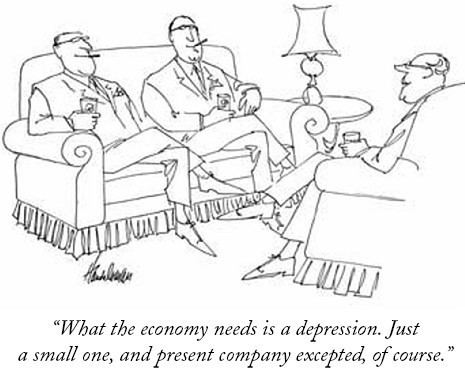Name J. Handelsman Role Cartoonist | Education New York University | |
 | ||
Died June 20, 2007, Southampton Books Freaky Fables, Further Freaky Fables | ||
John Bernard "J.B." Handelsman (February 5, 1922 – June 20, 2007) was a cartoonist and illustrator whose work appeared for decades in The New Yorker, Punch, Playboy, and other United States and British publications.
Contents

Biography
Self-satisfied businessmen, grown stout round the middle, featured frequently in the cartoons of JB Handelsman. Bernard "Bud" Handelsman did not look like his creations, more like a poet. Though he was lean and lank and his bearing was scholarly and serious his cartoons were, and still are, sharp and funny. Bud was born in the Bronx, New York, and had his first cartoon published in 1961. He moved to London in 1963 with his second wife Gertrude and his three children Jonathan, Peter and Constance. Bud made the move because he thought his style more suited to Britain than the US, which was odd because the people in his cartoons always seemed like New Yorkers, and the Bronx clung to him like a fog. He lived in England until 1982 but said he always felt like a stranger. That may have had more to do with his temperament than nationality - his cartoons have the detached, ironic view of an outsider.
He arranged a cartoon as if was a film set and could get a lot in a frame without it ever looking crowded. Bud studied at the Art Students League art school in New York and at New York University, and worked as a graphic designer; you can see that discipline in the deft way he organised tone and texture on the page. You could spot a Handelsman, pinned on an art room wall, at 50 paces.
Cartoonists can be an unsociable morose bunch, and Handelsman toed that party line; it was rare to hear his laugh ring out across a crowded room, but his dark wit lit up the pages of Punch, Playboy and the New Yorker. The themes of sex, status and money run through much of his work, which is why his cartoons will not date: "Marvin still has plenty of virility," a smug wife says, patting her smug, portly husband "although of course these days it goes into real estate." "May I suggest to Madame that Monsieur do the ordering?" a waiter suggests to a plump well-heeled couple, "otherwise there may be incalculable harm to Monsieur's self image."
Bud had a bit of a thing about names. He didn't much like being called Bernard and awarded himself the name John in adulthood. I can't remember anyone ever calling him that. He was also in the habit of sending in cartoons under the pseudonym of TR Squink without making any attempt to disguise his style. They got printed under Squink's name, but everyone knew they were Bud's.
For 11 years he did a strip for Punch called Freaky Fables and set great store by this work. Now those strips seem a little ponderous and lack the unsettling wit of his cartoons.
He also illustrated many books including Families and How to Survive Them (1983) and Life and How to Survive it (1994), both by John Cleese and Robin Skynner. Cleese called Bud "the best cartoonist alive". There was also The Mid-Atlantic Companion (1986), by David Frost and Michael Shea, plus a number of books for children. Bud also devised a 10-minute animated film for the BBC called In the Beginning, based on the Biblical story of the Creation.
Like most cartoonists, he had a natural contempt for writers; unlike most cartoonists, he was a good writer in his own right. I was working on Punch when he began to contribute short stories, including a grief-laden piece in which a man recalls the short life and death of his baby grandson. We published the piece under whatever pseudonym Bud was using at the time. One lady phoned up to say how much the story had moved her. I took the call. It was from Mrs Handelsman. Bud had not told her he had written the piece and she, like many other readers, was overwhelmed by the stark directness of the writing
Bud contributed nearly 1,000 gags to the New Yorker, about as many again to Punch, and just kept on going. Punch ceased publication in 2002, but Bud continued publishing cartoons in the New Yorker until shortly before his death. Cartoons on death were one of his many specialities. "First the good news," a doctor says drawing up the sheet over the face of the just deceased, "his temperature has gone down."
He was survived by his wife Gertrude, a daughter and two sons.
· John Bernard "Bud" Handelsman, cartoonist, born February 5 1922; died June 27 2006
From an article written by Susan Jeffreys in The Guardian newspaper
Cartoons
Illustration
Animation
He devised a 10-minute animated film for the BBC called In the Beginning, based on the Biblical story of the Creation.
